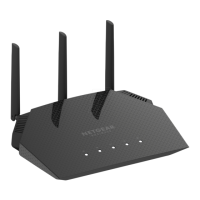3.
Enter http//www.routerlogin.net in the address field.
If you are not connected to the access point network but to the same network as the
access point, enter the IP address that is assigned to the access point. If you do not
know the IP address, see Find the IP address of the access point when you cannot
use routerlogin.net on page 27.
A login window displays.
If your browser does not display the login window but displays a security message
and does not let you proceed, see Log in to the access point after initial setup on
page 30.
4. Enter the access point local device password.
The local device password is the one that you specified. The local device password
is case-sensitive.
The BASIC Home page displays.
5. Select ADVANCED > Security > Block Services.
The Block Services page displays.
6.
The first time that you add an outbound firewall rule, in the Services Blocking section,
specify how the access point applies outbound rules:
• Per Schedule. Use keyword blocking according to a schedule that you set.
For more information, see Schedule blocking [router mode] on page 96.
• Always. Use keyword blocking continuously.
7. Click the Add button.
The Blocking Services Setup page displays.
8.
From the Service Type menu, select User Defined.
9.
Specify a new service blocking rule by selecting a protocol, defining the ports, and
defining a name:
•
Protocol. From the menu, select the protocol (TCP or UDP) that is associated
with the service or application. If you are unsure, select TCP/UDP.
•
Starting Port. In the field, enter the start port in the range from 1 to 65535 for
the service or application.
•
Ending Port. In the field, enter the end port in the range from 1 to 65535 for the
service or application.
•
Service Type/User Defined. In the field, enter the name of the custom service
or application.
User Manual92Security, Firewall, and Access
Rules
WiFi 6 AX1800 Dual Band Wireless Access Point WAX204

